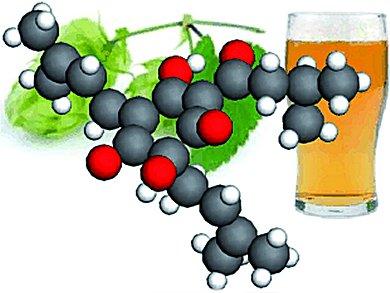The absolute configurations of the bitter acids of hops determined
During brewing, beer obtains its bitter flavor from the bitter acids that come from hops. In the journal Angewandte Chemie, scientists now report that they have used X-ray crystallography to determine the absolute configurations of these humulones and isohumulones, as well as several of their derivatives.
Humulones are bacteriostatic bitter substances from hops (Humulus lupulus) and act as natural preservatives. When beer wort is heated together with hops, rearrangement products are formed. These bitter compounds, known as iso-α acids or isohumulones, give beer its characteristic flavor. In addition, extracts of hops, such as the more stable tetrahydro-iso-α acids used by some brewers instead of hops, have been developed.
When humulones rearrange, a ring containing six carbon atoms converts into a five-membered ring. At the end of this process, two side groups may be arranged in two different ways: They can be on the same side or on opposite sides of the plane of the ring. The former arrangement is called the cis form and the latter is the trans form. But, in the cis-isohumulones, do the two side groups point up or down? And in the trans-isohumulone, which side group points up and which points down? In the six-membered ring of the original humulone there is a carbon atom in the ring with two different side groups attached to it. What is the absolute configuration (the “handedness) at this carbon atom?
A team headed by Werner Kaminsky has successfully answered these questions by means of X-ray crystallographic analysis. This project, undertaken by scientists at KinDex Therapeutics (Seattle) and the University of Washington (Seattle), was complex, because the isomerization process of humulones results in a large number of very similar compounds that had to be separated, purified, and the acids converted into suitable salts.
The absolute configurations of the hops bitter acids found by Kaminsky and his co-workers contradict some of the results previously reported in the literature, which raises the question of how suitable the indirect methods (Horeau method, Cotton effect) used for these studies really are for such investigations. Thanks to their new insights, the researchers have now also been able to determine the mechanism of the rearrangement in detail.
Why is the configuration so interesting? Although excessive beer consumption is not recommended, there are some indications that the hops bitter acids may have positive effects on diabetes, some forms of cancer, and inflammation, as well as weight loss. However, the effects seem to vary substantially depending on the absolute configuration. In addition, the various degrees of bitterness in beer seem to depend on the different forms of the tetrahydro-iso-α acids. Now that their stereochemistry is definitively known, these conjectures can be seriously tested, since the binding of iso-α acids to proteins requires that their “handedness” be compatible—like nuts and bolts.
- Absolute Configuration of Beer’s Bitter Compounds,
Jan Urban, Clinton J. Dahlberg, Brian J. Carroll, Werner Kaminsky,
Angew. Chem. Int. Ed. 2013.
DOI: 10.1002/anie.201208450



